This page has information on the following people:
- Billy Holt
- Halstead family
- Tatham family
- Eastwood(e) family
- Tommy Stansfield
- Hebden Bridge Rats Motor Cycle Club
BILLY HOLT - traveller, broadcaster, socialist, writer and painter
Billy Holt was a well known character in the Upper Calder Valley. He was born in 1897 in Todmorden. He lived at Holts Botanical brewery in Stoney Lane, Charlestown in about 1900 (for description of the brewery, see Oakville, Old Charlestown and Calderside page).
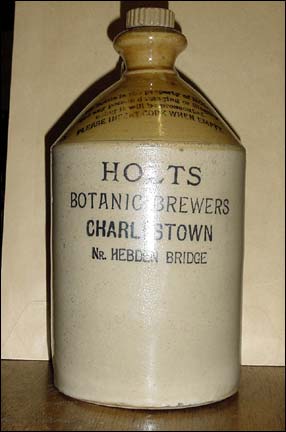
At the age of twelve he became a half timer (half working at a textile works and half at school).
After being in the army during the First World War, he had a short time at Trinity College Oxford and came back to the valley to set up a holiday camp at Hardcastle Crags.
Traveller
He travelled all over the world including a round the world trip as a deck hand, trips to USSR, Lisbon, Spain etc. Probably his most famous journey was in 1964 when he wrode a horse called trigger to Rome. His travelling style which included a wooly bobble hat, a goatee beard, eccentric behaviour and riding a white horse created a striking image to the inhabitants he passed on the way. This epic journey is recorded in his book 'Trigger in Europe'.
Political activist
In 1927 he formed a branch of the National Unemployed Workers Movement and in 1932 was arrested following a march against the means test committed to Wakefield prison for 9 months. He was briefly elected to the Town Council as a member of the Communist Party, but did not really fit in with that form of political action.
Broadcaster and Journalist
He was briefly the editor of the Todmorden Gazette and in 1936 became a war correspondent in Spain for the Daily Despatch. During the Second World War, he did regular broadcasts for the BBC Overseas service, continuing after the war to broadcast on industrial topics.
Writer
He wrote nine books in all, the best known being his two part autobiography 'I haven't unpacked' and 'I still haven't unpacked'. Unfortunately, none of these are in print at present, but all can be borrowed from the library at Todmorden. The trustees of Billy Holt have also published a small illustrated pamphlet which is available from the library price £1.50.
Painter
Billy Holt's painting style is difficult to describe, he certainly seems to have been influenced by the surrealists and William Blake. The canvases are of a monumental size and four of them can be seen at the Fielden Centre at Todmorden.
THE HALSTEAD FAMILY
the Halstead family were small to medium gentry who came over to Erringden from Habergham Eaves, near Burnley. They were well know business family in the district in the 19th and 20th centuries.The family who were teetotalers, were active in the community through the chapel, the International Order of Good Templars and some of the family were Masons.
We are grateful to Mrs Suffolk who provided much of the information about the Halsteads.
- Robert Halstead was listed as being a yeoman and died in 1614.
- His son George Halstead, also a yeoman was born on 24th september 1604 at Heights Farm in Erringden. He married Elizabeth Whittaker (born 1609). George died at Heights Farm on 5th June 1643.
- His son Robert, also a yeoman, was born at Heights Farm on 22nd February 1635. He was married to Tama Kay of Colden. Robert built Oaks Farm and Hillhouse Farm. He owned Burnt Acres, Higher and Lower Oaks, lodge and two farms at Colden. He died on 27th January 1715.
- His son George, also a yeoman, was born in 1662 at Higham Farm. He was married to Grace Wadsworth.
- His son Robert, also a yeoman, was born at Oaks Farm on 23rd October 1706. He was married to Mary Gibson, daughter of James of Bridgeroyd. She died at Oaks Farm in 1782. Robert died at Oaks on 22nd August 1796.
- His son George, listed as a farmer, was born at Oaks Farm in 1776. He was married to Mary Helliwell, daughter of William of Mulcture Hall. She was born in 1776 and died on the 19th October 1861. George died on 28th March 1858. Both are buried at Eastwood Chapel.
- Their daughter, Grace was married to William Dawson of Todmorden.
- Stephen Halstead lived at Cruttenstall farm at the time William Cockroft started Wood mill in 1875. (William married Stephen Halstead's sister.)
- Stephen had 4 daughters, Ellen, Betsy (who married into the Hitchen family of Hitchen and peels), Clara and Caroline (who married Teddy peel); 3 sons, Josiah, Fred and Edward (who married Hannah Peel). At some point Stephen is thought to have lived with his oldest son next door to Phillips butcher shop in Halifax Road (next to the school).
- Josiah had a daughter, Winnie who survived smallpox and never married. He had 4 sons, Eric (who had one son who died in his teens), Maurice and Stephen who emigrated to South Africa and Sydney. They all were qualified engineers.
- Josiah wanted Sydney to join the firm (which was now flourishing and employed many men. There was a disagreement in the family, so Josiah and Sydney set up their own undertakers firm in Todmorden (Josiah always kept a laying out board at the ready behind the kitchen door.
- Fred had one son called Frederick . Edward had three children and served in the Boer war as a medical orderly.
- Edward's daughter, Joan (born 1916), became a GP when few women qualified as doctors.
- Frederick, who did not marry trained as a surgeon in the 1920s. He was the organist at the Chapel for many years.
THE TATHAM FAMILY
We are indebted to Dave Whittaker who provided the information on the Tatham family from his family research.
From fairly humble origins, the Tathams rose to pay a prominent role in the commercial and civic life of the area between the late 19th and the mid 20th centuries.
Moving from Hebden Bridge around 1860, Robert Tatham (1837 - 1908) gained employment as a domestic servant at Stoodley Hall. At various times he is listed in the censuses up to 1891 as a gardener, groom and coachman, although curiously on one of his sons' marriage certificates and his own death certificate he is recorded as having been a 'land agent' - some snobbery at work here perhaps?
Robert married Martha Sutcliffe (1842 - 1910), a local woman who lived at Causeway Side, a small terrace of cottages on what was known as Stoodley Lane (now Lee Bottom Road). At one time there were eleven of the Sutcliffes living at this address - the buildings are still there. In her early years, Martha was a milliner and seamstress. She was also illiterate, at least until the birth of her second son; her marriage certificate and two birth certificates are marked with the customary 'x' instead of a signature.
After their marriage in 1863, Robert and Martha moved into a cottage at Gut Royd, off Stoodley Lane, where their first son, John James, was born in the same year, probably conceived out of wedlock. By 1866, the family had moved to lodgings by Stoodley Hall, where their second son, Charles Robert, was born in that year. A third son, Thomas Edward, was born in 1874, but sadly died in the following year. The family had moved into Stoodley Lodge by 1891, although John James had married and moved out by this time, to Victoria Terrace on Halifax Road. Martha and Robert had moved from the Lodge by 1901, also to Victoria Terrace. After Robert's death in 1908, Martha moved in with her younger son and his family at Calder Bank, where she died in 1910.
John James found employment as a cotton manufacturer's clerk. He was clearly successful in advancing himself, as by 1896 he was joint owner of Nanholme Mill which manufactured cotton goods with a Mr. Marshall.
John James married judiciously, you might say. His first wife, from 1888 to her death in 1925, was Susannah, a member of the Mitchell family of Middle Stoodley, who were coal merchants. By 1901 they had taken over Stoodley Lodge from the older Tathams; their only child, Lilian, was born here in 1906. Following Susannah's demise, John James married again, in 1927, this time Mary from the Moss family of Bridge Royd House. He went on to become a Justice of the Peace.
Charles Robert also became a cotton manufacturer's clerk, eventually being employed as a cotton cloth salesman, working with his brother. The company's sales office was located in the centre of Manchester.
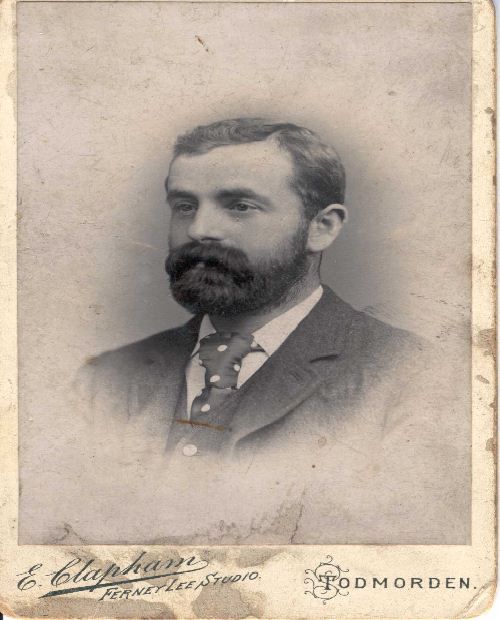
He married Florence Elizabeth Short, from Staffordshire, in 1896. They moved into a house in Victoria Terrace on Halifax Road but by 1910 had moved to Calder Bank, adjacent to Nanholme Mill.
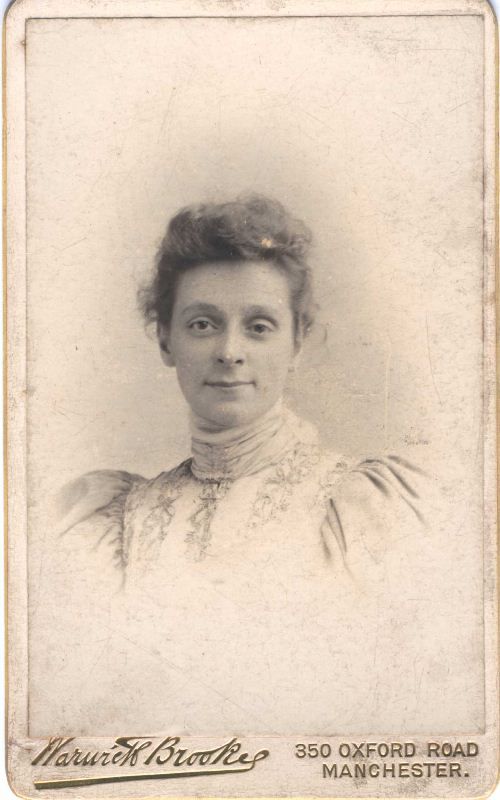
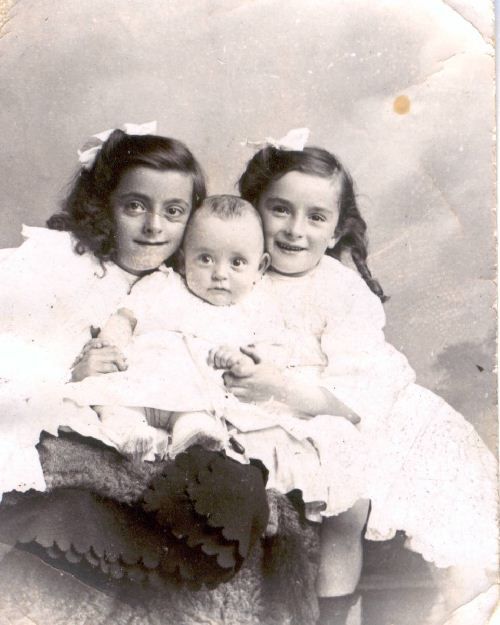
Three children were born: Dorothy (1898 - 1990), Floss - known as 'Cissie' (1899 - 1999), and Robert (1906 - ?).
Dorothy eloped with her cousin Thomas Albert Blane in 1920 as her parents disapproved of the match, although after the marriage they returned briefly to live at Calder Bank later in the decade, finally leaving the area for good.
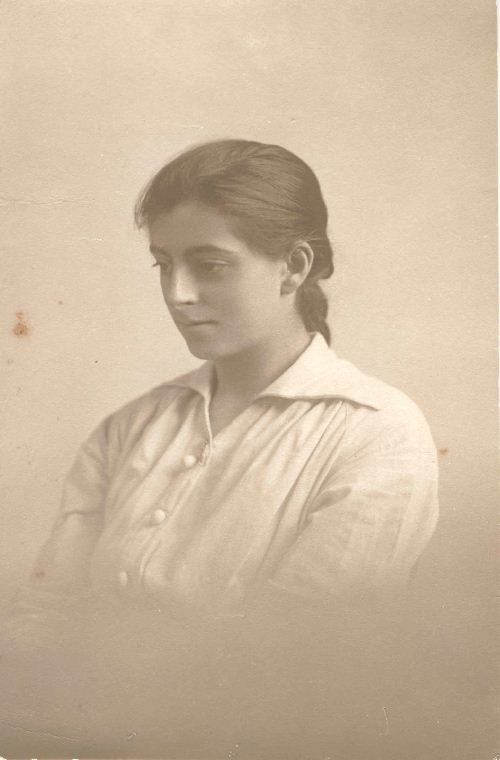
Charles Robert died in 1926 and his wife and two youngest children moved out of Calder Bank to another house in the area. The old man was plagued by boils and carbuncles in later life, which had a perhaps not unpredictable effect upon his temperament.
Floss never married and stayed with her mother until Florence's death in 1954; by that time they had moved away to the Manchester area, close to Dorothy and her family.
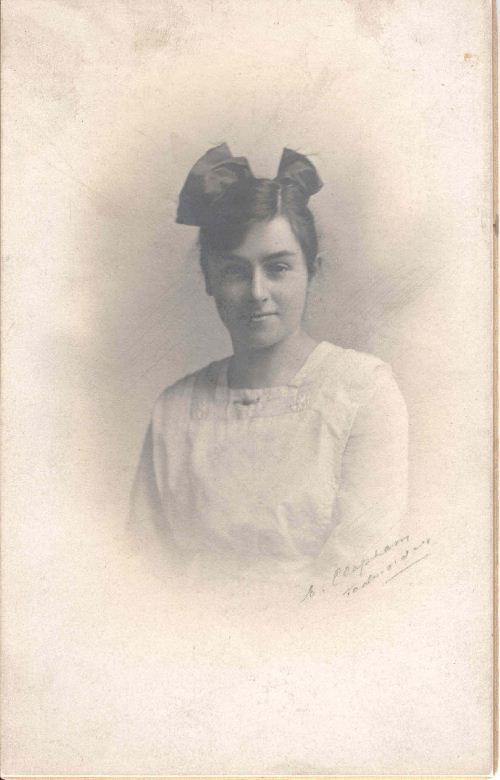
Not much is known about Robert, possibly due to a family falling out some time ago. Robert remained in the area, although he eventually retired to Bolton Abbey. At some time, Robert took over Nanholme Mill from his uncle. He married Edith Dawson in 1929, herself the daughter of a cotton manufacturer. Edith became a Councillor for the Liberal Party in the inter war years. The couple had two daughters, Joan Catharine and Shirley. Joan had a daughter, Joanna who lives in New York (who has contacted the history group) and a son, Ian Nicolas. Shirley now lives in Aachen, Gemany and has three sons.
Robert remarried in the 1960s to Thora Barnes. They moved to Northumberland in the 1970's and he died there in early 1984/85. His second wife died in 1988.
The Tathams were staunch Methodists and several of the marriages mentioned above took place at Mankinholes Chapel, where the family burial plot is also to be found. The Chapel itself was decommissioned in 1979 and has been converted into a house, but the graveyard remains open.
THE EASTWOOD(E) FAMILY
The following information has been provided by Jack Shackleton late of Higher Eastwood who did much research on the family. It takes us up to the end of the 17th century.
The name Eastwood almost certainly came from the Eastwood family who lived in the area since the 13th century. The name originally ended with an e and we are unsure when this was dropped.
The family motif is an arrow which can be seen in their coat of arms and on three buildings in Higher Eastwood.
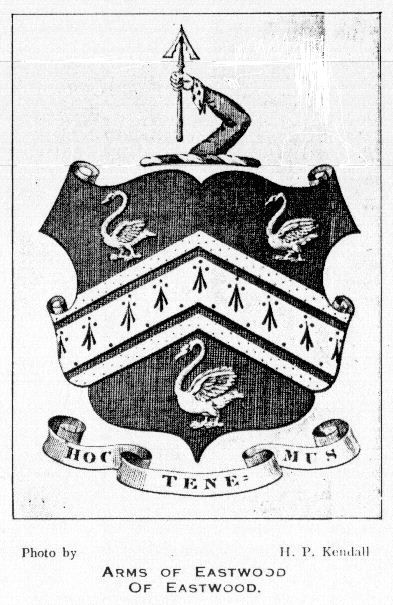
The most detailed history of the Eastwood family can be found in the 1916 transactions of the Halifax Antiquarian society in a chapter by a Mr A.Newell (copies can be seen at Todmorden and Hebden Bridge Libraries). The following list traces the family though more than five centuries.
- At a court in Wakefield held on july 13th 1275 Richard De Eastwode a forester and three associates were prosecuted for trespass (and possibly killing a stag). They were fined 10 shillings.
- 1296 Roger De Eastwoode was a juror in the Halifax Tourn (local court). He was hearing a case of a hedge encroaching a highway.
- 1298 He was in court as a pledge for two neighbours, Henrie De Schawe and Harie De Stoodley (these obviously have given their name to Shaw and Stoodley). They were charged with escapes, presumably referring to cattle or deer being allowed to escape on to other people's land.
- 1356 The poll tax returns list William Eastwode, son of Richard.
- 1356 William Eastwode appeared in court with his sons Richard, John and Roger.
- 1364 Roger De Eastwoode (junior) was a witness in a local court when when Richard was left land by a William le Scissor.
- 1380 John Eastwode was recorded as being a constable of Stansfield.
- 1449 Erringden deer park was dispailed and split into seven parts. Ralph Eastwoode got one part consisting of two pieces of land(possibly one at Cragg Vale).
- 1482 In July one of the chaplains from Halifax church dies and in this will he states "I bequeath to William Eastwod another russet gown".
- 1532-1557 Richard and John are witnesses to many wills often for people in Heptonstall.
- 1545 First will of an Eastwoode, the two beneficiaries are Sir Christopher Bentley and Sir William Aspden. Six witnesses included Sir John Greenwood.
- 1551 George Eastwoode was buried in Heptonstall churchyard.
- 1554 John Eastwood of shore, a yeoman died and was buried in Heptonstall church.
- 1591 The will of John Eastwood mentions his wife Margaret and sons Richard, William and John. John was apparently the eldest child and had five children John, Samuel, Luke, Bridget and Mary. Richard had two children, Richard and Christobel.
- 1593 Heptonstall register records the marriage John Waddesforth to Grace Eastwood.
- 1629 The will of John Eastwood was proved in 1631. This John Eastwood was reputed to have refused the offer of a knighthood from Charles the First. His eldest son, also John was left the land at Higher Eastwood with cottages. Bridget and Mary were left £3-6s-8d a year and the servants got 10 shillings each.
- 1634 Another will to the son and heir - yet another John sets out 4 ploughs, 5 ribtrees (part of horse and cart gear), 5 firepotts, iron shod wheels and two looms in the barn.
- 1663 The will of Thomas Eastwood surrendered 20 acres of land to the Lord of the Manor Ightenhill (probably from Padiham). One can only assume that this was for taxes or perhaps a debt. The will then demonstrated prevailing attitudes to gender at this time. It leaves one third to his wife on trust, then to "the first male child of his or later issue, male only, in default to second son and so on until sixth or successive male and then to every daughter of said Thomas Eastwood and heirs...." Interestingly he then leaves "to his faithful servant Lily Radcliffe who has leave to dwell in the new house in the fold (refers to 5,6,7 & 8 Higher Eastwood) for life and a cow kept there or £5 per year in lieu". This would have been extraordinarily generous, prompting suggestions of a special relationship between master and servant!
- 1677 The will of William Eastwood left his wife Sara "land and dwelling at Baldwinroyd until Richard be 13 for bringing up 6 children". several members of the family are overseers, wardens and witnesses for the Parish of Stansfield.
By the second half of the 19th century, the Eastwood family seems to gone into the legal profession either as lawyers or magistrates. In 1896 when Todmorden was granted the charter of incorporation a mr. Eastwood was nominated provisional mayor.Many of the Eastwood family were buried in Heptonstall church so we hope that further research will carry on the history of this influential family.
TOMMY STANSFIELD
Tommy Stansfield (also known as Nudger) built many of the houses in Charlestown. He was born in 1871 at the Nudger Inn where his father was landlord and from which his nickname "Nudger" originated. Tommy started work at the age of 10 as a part timer at Callis Mill and later moved to Hebble End Mill, but he never really settled to factory life. He began working as an odd job man on the house his father built at Fielden Hospital (strangely named Puzzle Hall) and worked as a mason at Stoodley Pike quarry.
Having found his vocation, he set up on his own in the 1890s and over the course of the next 60 years, he built well over 100 houses and some industrial buildings (including Holts Picker works at Eastwood). Tommy restored many of the original buildings in the area using stone from the quarry he owned at Calderside.
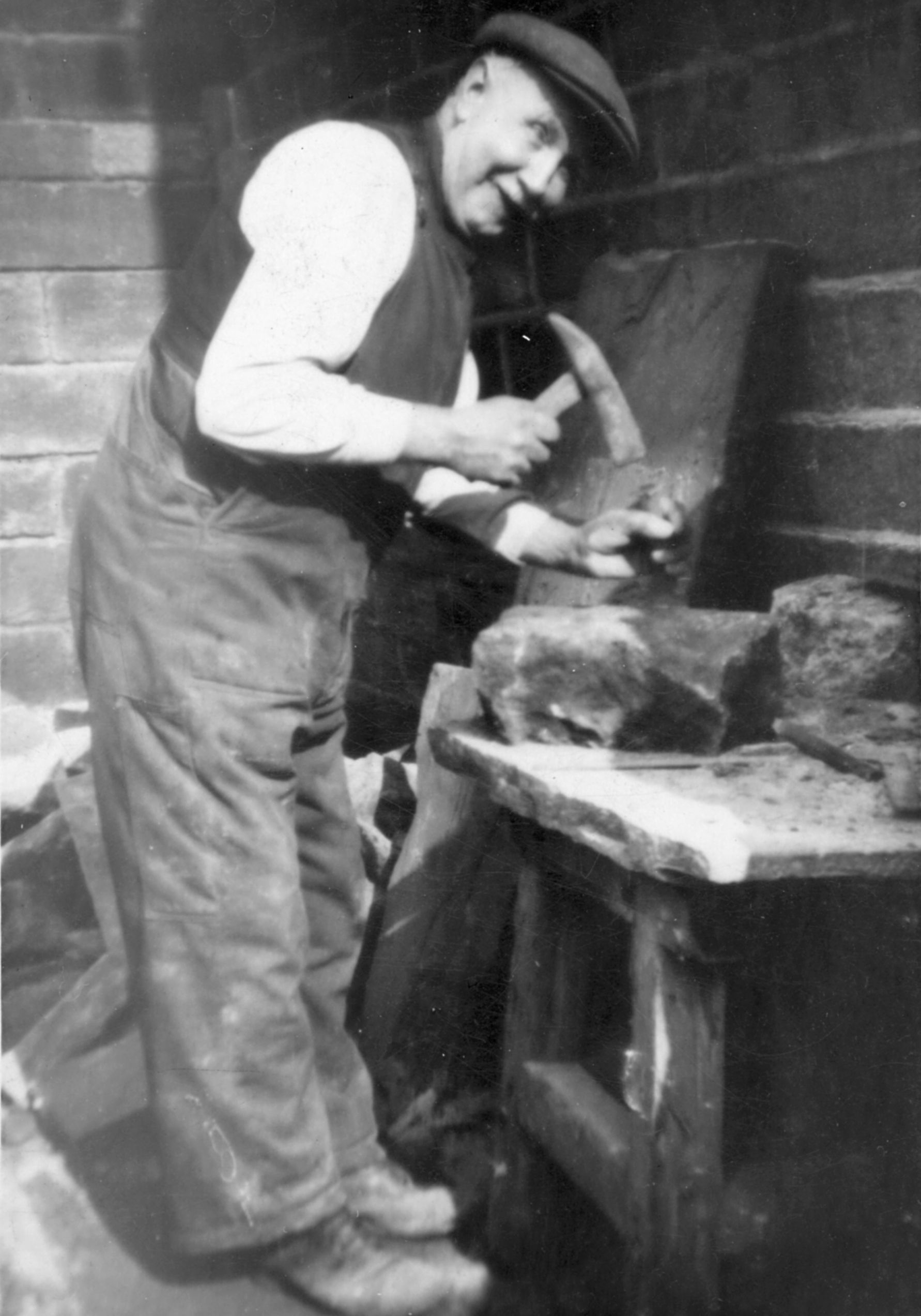
Tommy lost an eye in an accident at Staups Dam in the 1920s, but continued to work at a pace which men 50 years his junior were said to be hard pressed to keep up with. Tommy was a Blackshaw Parish Councillor for many years and was the first surveyor for the council. Tommy who was a lifelong bachelor and non smoker, died at Ingledene, Underbank Avenue, the house he built for himself.
THE BRIDGE RATS MOTOR CYCLE CLUB
Bridge Rats MCC History
In the 1960s, John "Chappy" Chapman Bridge Rats, current president formed a club called the "51" club which was rocker based and had 12 members.
In 1991 there was an advert in the local paper about a new motorbike rally club starting in the Calder valley at the Woodman Inn, Charlestown, and this is how the Calder Valley MCC was born. The club went to rally's and bike runs and the club got bigger and bigger but sadly the club was not doing what Chappy thought it should be and he and some of the members left and formed their own club in 1993.
The newly formed club had a logo that had a bridge for Hebden Bridge and a rat as Chappy’s father was a desert rat in WW2. A meeting was held at Blackshawhead pub and 7 people turned up (it was winter) and the new club Bridge Rats rally club was formed and its new club logo was worn.
The club stayed at the Blackshawhead pub for about another year and then the they moved to the Woodman Inn where the club had some great fun, but sadly the Woodman Inn closed down and the club moved to the Trades Club in Hebden Bridge in 1999. The club stayed at the Trades Club for about 10 months but as the club got bigger and stronger they where out growing the size of the Trades Club so they voted to find a bigger venue.
They moved to the Stubbing Wharf in June 2000 but by 2011 they had moved to the Shoulder of Mutton in Hebden Bridge. They still attend rallies, shows and visit other clubs.
This page was last updated April 2009